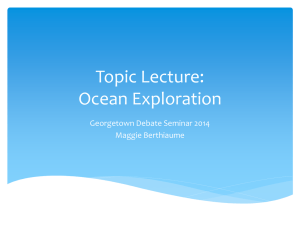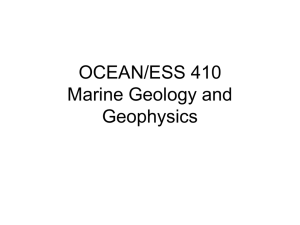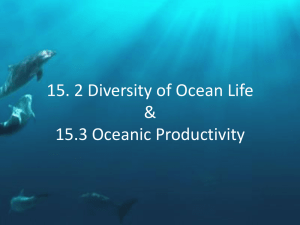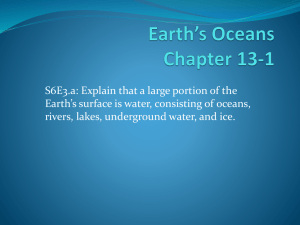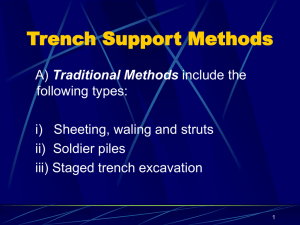Marianas Trench_23April2013
advertisement
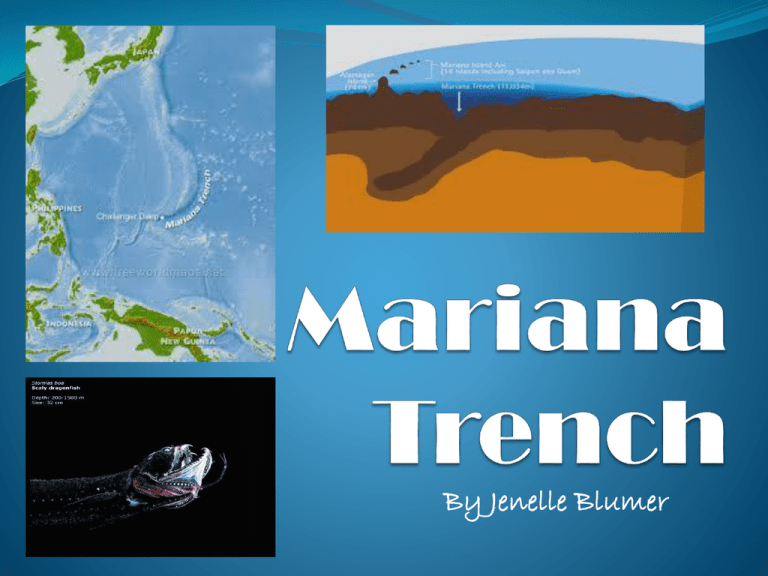
By Jenelle Blumer The Marianas Trench. Hmm… that strikes a bell, doesn’t it? Its the name of a Canadian band! Not even close. In truth, there is a band by the name of the Marianas Trench. However, the Marianas Trench I researched about is the deepest part of the world’s oceans, a trench located in the western Pacific Ocean, to the east of the Mariana Islands. It is an extreme environment. While thousands have climbed Mount Everest, the highest peak on earth, only a precious few have ventured down to the deep, dark, mysterious crack in the floor of the Ocean! The deepest part of the Trench is Challenger Deep, a deep crack in the Trench approximately 35,994 feet (10,971 m) in depth. Place The Mariana/Marianas Trench is a crescent shaped scar in the ocean floor of the Atlantic. It measures more than 1,500 miles (2,550 kilometers) long and 43 miles (69 kilometers) wide on average. It was formed when two tectonic plates collide. At the collision point, one of the plates dives beneath the other into the Earth’s mantle, creating an ocean trench. It is cloaked in darkness with the water pressure weighing tons, and surprisingly contains many significant types and breed of fish despite the pressure, which increases with depth. Mariana Trench was claimed by Spain in 1668. Spain established a colony there and gave the islands the official title of Las Marianas in honor of Spanish Queen Mariana of Austria. Did you know that the moon has been more explored than the Mariana Trench? Size It is extremely difficult to measure the depth of the Marianas Trench, due to the difficult task of delivering instrumentation to such a remote location and then obtaining accurate readings. However, the most recent measurement of the Trench, obtained by a U.S. research team in (GEBCO Gazetteer of Undersea Feature Names in 2011), recorded the depth as 10,994 metres, yet with only a width of 43 miles. The first attempt as measuring the depth of the Trench was in 1875 during the Challenger Expedition, when a sounding of 26,850 feet (8,184 metres) was obtained near the southern end of the trench. If there is any trouble in understanding the depth of the Mariana Trench, just look at it this way— if somebody were to fit Mt. Everest, the highest land mountain on earth at 29035 feet, into the Challenger Deep, there would still be at least 7000 feet left over. That’s how deep it is. The water pressure on the floor of the trench is more than 8 tons per square inch (703 kilograms per square meter), the equivalent of having 50 jumbo jets piled on top of a person! Most of the trench is black, with no significant source of light except for glowing fish. The trench's floor has hydrothermal vents that emit highly acidic fluids. The temperature around the vents can reach temperatures of 572 degrees F (300 degrees C). Conversely, the water at the seabed floor is very basic and hovers between 34 and 40 degrees F (1.1 and 4.4 degrees C). The contrast between the two creates an ever-changing and nearly-toxic environment. Even so, miraculously, life thrives. • • • • • • Trieste The first time humans descended into the Challenger Deep was more than 50 years ago, when Don Walsh and Jacques Piccard boarded a bathyscaphe called the Trieste to pinpoint and survey the area. The bathyscaphe, meaning deep boat, was Swiss designed and Italian built. The two of crew that boarded it were both Oceanographers, and both successfully completed Project Nekton. Jacques Piccard was actually the son of Auguste Piccard, who designed the Trieste. Because of the fact that Auguste broke the highest altitude hot-air balloon, the Piccard family holds the record of highest altitude balloon fight AND deepest ocean dive. Don Walsh, the other crew member, had been associated with ocean science, engineering, and marine policy for over 50 years. HE was an officer for the U.S. navy. A big problem that occurred was that when the Trieste landed on the bottom gently, the clouds of silt rose and did not settle before the Trieste rose back up again, thus preventing them from taking any clear pictures in the Challenger Deep Technology used to explore/survive The waters covering our planet are vast, taking up over 70 percent of its surface. Beyond the coastlines of Earth’s major continents, however, the ocean remains virtually unexplored due to the risk of the danger waiting beyond the calm waves as seen from a beach. Engineering is an important part of Oceanology. After all, ocean exploration isn’t all about throwing off your clothes and jumping in, right? Technology is very essential in cases of Extreme Environments, which in this case would be the Mariana Trench, because of obstacles that await us, such as… • • • • • • • Water pressure (over 8 tons per square inch) Lack of Oxygen Must possess permit Very cold (1-4 degrees Celsius) Noxious fumes released from hypothermal vents Unknown and possibly dangerous creatures If anything goes wrong, it’s a long way home Vessels are probably the most critical element in any venture beyond the shores. In the case of research vessels the ships must also be equipped with special tools and technology that allow scientists to explore ocean environments. Research vessels are highly advanced mobile research stations, providing stable platforms from which explorers can deploy equipment, divers, and submersibles. Not only that, these vessels carry electronics, computers, and navigational and communications systems. Submersibles are small vehicles designed to operate underwater. Unlike submarines, submersibles cannot go very far by themselves; they rely on a larger vessel, such as a ship, to carry them to their destination, charge their batteries, or supply air and oxygen. Many submersibles these days are ROVs (Remotely Operated Vehicles). Instead of traveling with the ROV, the operator stays on the ship and controls it remotely by computer, while watching video images sent back by the submersible. ROVs are particularly useful for exploring in water that is too deep or dangerous for humans. Submersibles are small vehicles designed to operate underwater. Unlike submarines, submersibles cannot go very far by themselves; they rely on a larger vessel, such as a ship, to carry them to their destination, charge their batteries, or supply air and oxygen. Many submersibles these days are ROVs (Remotely Operated Vehicles). Instead of traveling with the ROV, the operator stays on the ship and controls it remotely by computer, while watching video images sent back by the submersible. ROVs are particularly useful for exploring in water that is too deep or dangerous for humans. Certain tools, such as sondes, CTDs, and drifters, provide specific information about the ocean environment. Other instruments, such as satellites, provide generalized data from which a wide range of observations can be made. The information gathered from the instruments deployed in the oceans and the sky will help us answer many questions about our world. When depths are not too great or conditions are not too unsafe, divers can descend into the water to explore the ocean realm firsthand. However, we are creatures evolved to live on land. Unaided by technology, people are about as helpless underwater as a fish on grass. The two most common types of diving are Scuba Diving and Technical Diving. Scuba diving is the most extensively used system for breathing underwater by recreational divers throughout the world and in various forms is also widely used to perform underwater work for military, scientific, and commercial purposes. Technical diving often involves the use of special gas mixtures (other than compressed air) for breathing. Canada Canada is one of the world’s leaders in Oceanography. After all, it is embedded next to 3 oceans. Although the contribution towards exploration of Mariana Trench isn’t the most, Canada is experienced in Oceanology of different parts of the earth. Some of the companies they own are: The Marine Institute, a Fisheries and Marine Institute of Memorial University of Newfoundland The Department of Science in the Dalhousie University, Canada's premier location for oceanographic research and education Ocean Technology Centre The government has established several firms up and down the country that specialise in research and producing ocean technology Why is exploring Mariana Trench so important? As populations grew, ancient peoples explored Extreme Environments to find new places to live. They also explored to find food, water, and other resources. Today, people explore to learn about the world and the universe, rather than to find a new place to live. However, some scientists and politicians talk about having a human colony on the Moon or Mars some day. It is important to explore Marianas Trench for unknown objects or animals that could help us in some way, for example to help us develop a new cure for cancer. We could also set up bases in Oceans, as planned in outer space Mind Your Carbon Footprint and Reduce Energy Consumption Reduce the effects of climate change on the ocean by leaving the car at home when you can and being conscious of your energy use at home and work. 2. Make Safe, Sustainable Seafood Choices Try not to order or buy seafood for meals— fish and marine animals are dying out and the best thing to do to solve the problem is to try to stop devouring them. 3. Use Fewer Plastic Products Plastics always end up in the ocean and kill thousands of marine life a year. To shorten the number, carry a reusable water bottle, store food in non-disposable containers, bring your own cloth tote or other reusable bag when shopping, and recycle whenever possible. 4. Help Take Care of the Beach Whether you enjoy diving, surfing, or relaxing on the beach, always clean up after yourself. Explore and appreciate the ocean without interfering with wildlife or removing rocks and coral. Go even further by encouraging others to respect the marine environment or by participating in local beach cleanups. 1. 5. Don't Purchase Items That Exploit Marine Life Certain products contribute to the harming of fragile coral reefs and marine populations. Avoid purchasing items such as coral jewelry, tortoiseshell hair accessories (made from hawksbill turtles), and shark products. 6. Be an Ocean-Friendly Pet Owner Read pet food labels and consider seafood sustainability when choosing a diet for your pet. Never flush cat litter, which can contain pathogens harmful to marine life. Avoid stocking your aquarium with wild-caught saltwater fish, and never release any aquarium fish into the ocean or other bodies of water, a practice that can introduce non-native species harmful to the existing ecosystem. 7. Support Organizations Working to Protect the Ocean Many institutes and organizations are fighting to protect ocean habitats and marine wildlife. Find a national organization and consider giving financial support or volunteering for hands-on work or advocacy. If you live near the coast, join up with a local branch or group and get involved in projects close to home. 8. Influence Change in Your Community Research the ocean policies of public officials before you vote or contact your local representatives to let them know you support marine conservation projects. Consider patronizing restaurants and grocery stores that offer only sustainable seafood, and speak up about your concerns if you spot a threatened species on the menu or at the seafood counter. 9. Travel the Ocean Responsibly Practice responsible boating, kayaking, and other recreational activities on the water. Never throw anything overboard, and be aware of marine life in the waters around you. If you’re set on taking a cruise for your next vacation, do some research to find the most ecofriendly option. 10. Educate Yourself About Oceans and Marine Life All life on Earth is connected to the ocean and its inhabitants. The more you learn about the issues facing this vital system, the more you’ll want to help ensure its health—then share that knowledge to educate and inspire others. The Mariana Trench was once proposed as a nuclear waste disposal site, in hope that tectonic plate subduction occurring at the site might eventually push the nuclear waste deep into the Earth's mantle. This is a bad idea— plate subduction zones are associated with very large mega thrust earthquakes! Besides, ocean dumping is prohibited bylaw.




